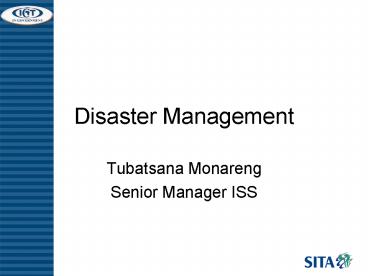Disaster Management - PowerPoint PPT Presentation
1 / 19
Title:
Disaster Management
Description:
The loss of applications used in critical business processes ... BCM is the process of developing organisation-wide resilience allowing an ... – PowerPoint PPT presentation
Number of Views:29
Avg rating:3.0/5.0
Title: Disaster Management
1
Disaster Management
- Tubatsana Monareng
- Senior Manager ISS
2
Agenda
- Recent Events
- All kinds of Disasters
- What causes Disasters?
- What are the effects of different Disasters?
- What is DRP, BCP, BCM and BPCP?
- PAS56 / BCM Standard
- What about backup?
- SITA DRP methodology
- Questions and Answer session
3
Recent events
- 9/11
- 2003 power outage in the Northeastern U.S.
- Madrid and London train bombing
- Hurricanes Katrina and Rita
4
- Airplane Accidents_at_
- Avalanches_at_
- Blizzards_at_
- Documentary Films_at_
- Drought in the Midwest_at_
- Earthquakes_at_
- Emergency Management_at_
- Fires_at_
- Floods_at_
- Hurricanes, Typhoons, and Tropical Cyclones_at_
- Landslides_at_
- Nuclear Disasters (7)
- Oil Spills (30)
- Organizations (67)
- Preparedness Guides (24)
- Public Health and Safety_at_
- Structural Failures_at_
- Tornadoes_at_
- Tsunamis_at_
5
Scores killed as Siberia Airlines jet crashes on
landing.An airplane carrying about 200 people
crashed Sunday in the Siberian city of Irkutsk
and most on board were feared dead, officials
said. The Sibir Airbus A310 crashed on landing,
veering off the runway and bursting into
flames.Full Story Discussion News
CenterToday's Other News 45 killed in
Pakistani airliner crash. - Full Story. Over
100 killed as jetliner crashes into Black Sea.
- Full Story. Russia enacts bill that allows
plane shootdowns. - Full Story.
6
An independent study of FCC outage report
7
Possible consequences of this
- Interruptions in the supply chain
- Needing to care for large group of people who
cannot leave the work place - Not having the workforce available to return to
work because of displacement of people from their
homes - The loss of applications used in critical
business processes - Lack of funding after a disaster, which may
result in longer recovery times
8
Cyberspace Threats and Vulnerabilities
- 9/11 were physical attacks, whilst we are facing
increasing threats from hostile adversaries in
the realm of cyberspace as well - IT revolution quietly changed the way business
and government operate - A network of networks directly supports the
operation of all sectors of our economy - The attacks are capable of causing debilitating
disruption to a nations critical
infrastructures, economy, or national security
9
Disaster Recover Planning
- DRP is the process of planning to ensure that the
business (normally IT focused) recovers from a
disaster as quickly as possible
10
Business Continuity Planning
- BCP is pro-actively planning to ensure that
resilience is built into business processes to
keep the business going without interruption when
a disaster hits. It is a combined process of
business recovery planning and technology
recovery planning
11
Business Continuity Management
- BCM is the process of developing
organisation-wide resilience allowing an
organisation to survive the loss of part or all
of its operational capability. It also looks at
surviving significant losses of resources. This
must be developed from senior management to the
operational level and across all functional areas
12
Business Process Contingency Planning
- BPCP is planning to protect critical business
processes from being interrupted by a disaster.
The plans provide contingency solutions to ensure
critical business processes are resilient.
13
PAS56
- PAS56 is the Publicly Available Standard for
Business Continuity Management - PAS56 is published by the British Standard
Institute (BSI) - PAS56 is based on Good Practice Guidelines (2005)
published by the Business Continuity Institute
(BCI) - Intention was to be British Standard (BS25999) at
the end of 2006 International Standard during
2007
14
Backup
- Backups are the most singular important
phenomenon of Business Continuity and Disaster
Recovery - Backup are about creation and the maintenance of
backup metadata and media management - Metadata and media management form the heart of
any data recovery system - Differential or incremental backup?
- The effect of mirroring and replication
- Off-site backups
15
(No Transcript)
16
SITA Methodology
- SITA DRP Methodology is similar to PAS56
- Phase I Business Impact Analysis
- Phase II Risk Assessment
- Phase III Strategy Formulation
- Phase IV Plan design
- Phase V - Testing
17
(No Transcript)
18
(No Transcript)
19
Questions???































